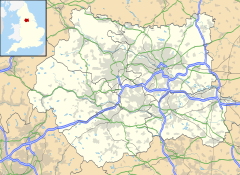Wrenthorpe
| Wrenthorpe | |
|---|---|
 Jerry Clay Lane in Wrenthorpe |
|
| Wrenthorpe shown within West Yorkshire | |
| Population | 7,165 |
| OS grid reference | SE315225 |
| Metropolitan borough | |
| Metropolitan county | |
| Region | |
| Country | England |
| Sovereign state | United Kingdom |
| Post town | Wakefield |
| Postcode district | WF2 |
| Police | West Yorkshire |
| Fire | West Yorkshire |
| Ambulance | Yorkshire |
| EU Parliament | Yorkshire and the Humber |
| UK Parliament | |
Wrenthorpe is a village north-west of Wakefield, in West Yorkshire, England. It is located in the Rhubarb Triangle.
Although earlier remains, such as Roman coins and pottery, have been found in the area, the current settlement dates from after the Domesday Book's compilation in 1086.
Pottery has played an important role in Wrenthorpe's history, building from the presence of a few potters in the 15th century, to a thriving cottage industry that peaked in the 17th century, before declining over the course of the 18th. Such was the scale of pottery production, the village became known as "Potovens," attributed to the kilns used to fire finished pottery. Reminders of this heritage can be found in local names, such as "Potovens Lane" and the remains of pottery and clay tobacco pipes that can be found in the soil.
As the potteries declined, coal mining, already present on a smaller scale providing fuel for the potters' kilns, expanded to meet the needs of the Industrial Revolution. Agriculture also grew more important to the area.
During the 19th and early 20th century rope and woollen textile production joined coal and agriculture as Wrenthorpe's major industries, both disappearing over the course of the 20th century.Rhubarb forcing houses were built in Wrenthorpe, contributing to West Yorkshire's extensive Rhubarb growing industry.
Wrenthrope is served by two state primary schools, Wrenthorpe Primary School and Jerry Clay Academy. Both are pyramid schools of Outwood Grange Academy in nearby Outwood.
...
Wikipedia

